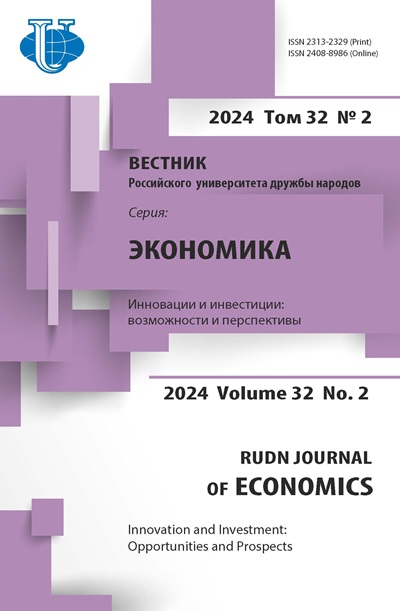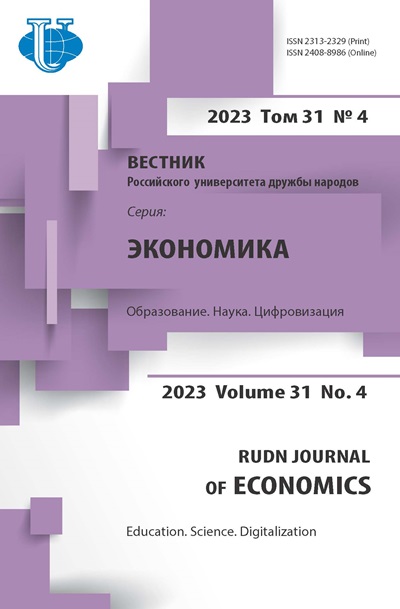Comparative analysis of the carbon market and the carbon tax mechanisms efficiency to achieve the goals of the global carbon footprint reduction
- Authors: Zavyalova E.B.1, Li J.1
-
Affiliations:
- MGIMO University
- Issue: Vol 31, No 4 (2023): EDUCATION. SCIENCE. DIGITALIZATION
- Pages: 740-759
- Section: INDUSTRIAL ORGANIZATION MARKETS
- URL: https://journals.rudn.ru/economics/article/view/37309
- DOI: https://doi.org/10.22363/2313-2329-2023-31-4-740-759
- EDN: https://elibrary.ru/SJRCKB
Cite item
Full Text
Abstract
The environmental agenda is decisive in the formation of the world economy at the present stage. The need for a green transition is rarely questioned by scientists. However, there remains a wide range of opinions about which instruments are the most effective in achieving the set goals of reducing the carbon footprint. The most popular mechanisms today are the carbon market and carbon tax mechanisms. Aim of the research was using modeling, literature analysis, and deduction methods to compare the similarities and differences between the basic principles of applying a carbon tax and a carbon market mechanism, the authors of the article identify the advantages and disadvantages of both approaches. The results of the research showed that the carbon market mechanism has obvious advantages such as flexibility, cross-industry and crossterritory coverage, and relative benefits for companies compared to a carbon tax mechanism. At the same time, the carbon tax mechanism has the obvious advantage of low management costs and wide coverage, but, on the other hand, these advantages are offset by potential inefficiencies and high “cost” for companies. The analysis of the policies of large countries with large carbon emissions over the past 2-3 years shows that they are more likely to introduce elements of the carbon market to reduce emissions. Based on the theoretical analysis of the main characteristics of the carbon market and carbon tax, as well as their advantages and disadvantages, the authors urge not to be limited to one of the options, but to use both mechanisms simultaneously. In particular, the carbon market should be the main mechanism when the goal is to create more incentives to actively reduce carbon emissions, while carbon tax policies can be an additional measure to incentivize or “punish” those enterprises that exceed emission standards, also, the carbon tax will help to involve those industries that, for various reasons, cannot be represented on the carbon market.
About the authors
Elena B. Zavyalova
MGIMO University
Author for correspondence.
Email: e.zavyalova@inno.mgimo.ru
ORCID iD: 0000-0001-6531-7672
Head of the Economic Policy Department
76 Vernadskogo Av., Moscow, 119454, Russian FederationJiacheng Li
MGIMO University
Email: 17603041262@163.com
ORCID iD: 0009-0003-4091-9767
MA in Management
76 Vernadskogo Av., Moscow, 119454, Russian FederationReferences
- Agapov, D.O. (2023). Carbon Market and its Development in Russia. Agricultural and Land Law, (1), 35–38. (In Russ.). https://doi.org/10.47643/1815-1329_2023_1_35
- Andronova, I.V. (2012). Energy audit for national energy security. GIAB, (5), 331–337. (In Russ.).
- Andronova, I.V., & Sokolan, D.S. (2021). China’s Direct Investment in Alternative Energy Sources in the EU. In E. Zavyalova, E. Popkova (Ed.), Industry 4.0: Exploring the Consequences of Climate Change. Palgrave Macmillan Cham. https://doi.org/10.1007/978-3-030-754051_10
- Cheng Xueqing. (2023). EU Carbon Emission Regulation. Innovation and Investment in Russia, (1), 67–70. (In Russ.).
- Elgouacem, A., Halland, H., Botta, E., & Singh, G. (2020). The fiscal implications of the lowcarbon transition.
- Komarovskaia, N.V. (2021). Formation of a Green Economy in Moscow: Opportunities and Prospects In E. Zavyalova, E. Popkova. (Ed.), Industry 4.0: Exploring the Consequences of Climate Change. Palgrave Macmillan Cham. https://doi.org/10.1007/978-3-030-75405-1_7
- Lukashenko, I.V, Sayaetdinova A.F. (2013). Chinese carbon market. Finance: Theory and Practice, 6, 212–121. (In Russ.).
- Mishchenko, Y.V. (2022). Global environmental agenda: Developments ahead, sustainable energyecological dimensions for Russia, Japan, and Southeast Asia. RUDN Journal of Economics, 30(4), 499–511. (In Russ.). https://doi.org/10.22363/2313-2329-2022-30-4-499-511
- Olivier, J.G., Schure, K.M., & Peters, J.A. H.W. (2017). Trends in global CO2 and total greenhouse gas emissions. PBL Netherlands Environmental Assessment Agency, 5, 1–11.
- Pilevina, Е.V. (2018). Problems of determining the income of foreign organizations in the source country of income. Competitiveness in the Global World, (1) (part 8), 962–964. (In Russ.).
- Piskulova, N.А. (2019). Carbon regulation: taxation. International Economic Relations: Reality and Challenges. (In Russ.).
- Piskulova, N.A. (2010). Development of the world economy: environmental vector. World Economy and International Relations, (12), 28–37. (In Russ.).
- Popkova, E.G., & Sergi B.S. (Ed.). (2023). Current Problems of the Global Environmental Economy Under the Conditions of Climate Change and the Perspectives of Sustainable Development. Springer Cham, 548 p.
- Ritchie, H., Roser, M., & Rosado, P. (2020). CO2 and greenhouse gas emissions. Our World in Data portal. Retrieved January 18, 2023, from https://ourworldindata.org/co2-and-greenhousegas-emissions
- Sandalow, D. (2019). Guide to Chinese Climate Policy. Columbia Center on Globa l Energy Policy, New York.
- Shuvalova, O.V., Stoyanova M. (2020). Successes of Denmark and Germany in the field of transfer of its economies from fossil to alternative energy sources. RUDN Journal of Economics, 2(28), 315–333. (In Russ.). https://doi.org/10.22363/2313-2329-2020-28-2-315-333
- Simonova, М.D., & Kozlov, K.V. (2020). Statistical analysis of the Chinese Energy Production. Data Science, 282–284. (In Russ.).
- Simonova, M. (2019). Prospects of renewable energy sources: the case study of the BRICS countries. International Journal of Energy Economics and Policy, 9(5), 186–193.
- Starikova, Е.А. (2021). Sustainable Development in the Changing World. Public and Private Participation. (In Russ.).
- Studenikin, N.V. (2015). The Perspectives of the Green Economy in PEF-2015, 485–492. (In Russ.).
- Swartz, J. (2016). China’s national emissions trading system. ICTSD Series on Climate Change Architecture, 20–23.
- Zavyalova, E., Popkova E. (Ed.). (2021). Industry 4.0: Exploring the Consequences of Climate Change. Palgrave Macmillan: Cham, 425 p.
- Zavyalova, E.B., Popkova E.G. (Ed.). (2022). Industry 4.0. Fighting Climate Change in the Economy of the Future. Cham: Palgrave Macmillan, 473 p.















